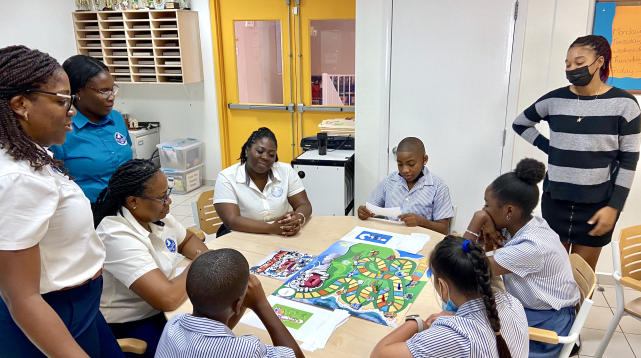RESILIENCE
Keeping Children Safe by Making Disaster Preparedness Fun
Child Resilience and Protection Project

- HURRYcane Run, a board game developed by the Student Support Services Division in collaboration with UNICEF the Netherlands, teaches children how to prepare for a disaster.
- Having recognized the gap in emergency response protocols specific to children, the Ministry of Education, Culture, Youth and Sport identified this area as critical for long-term resilience.
- The Child Resilience and Protection Project focuses on strengthening the capacity of Sint Maarten’s child protection system, nurturing the well-being of children and adolescents, and equipping schools to better respond to future disasters.
Bolstering Child Resilience to External Shocks
Nearly 10,000 children in Sint Maarten were among the most vulnerable victims of Hurricane Irma. The massive hurricane was one of the strongest ever recorded in the Atlantic. “It was very scary for me because I was younger,” says Keandra Harriot, 11, who was only 5 years old when Irma hit. “It was a big storm, and there was a lot of rain.” Alexander Williams, 10, described it as traumatizing: “I was staying with my grandmother, and our roof blew off.”
Keandra, Alexander, and their classmates at the Asha Stevens Hillside Christian School were among the first to play HURRYcane Run, the board game developed by the Ministry of Education, Culture, Youth and Sport’s Student Support Services Division and UNICEF the Netherlands as part of the Child Resilience and Protection Project. The game is an entertaining way to help educators teach children about the importance of hurricane effects and preparedness. Players win by getting to the finish line as quickly as possible and move ahead faster by answering hurricane preparedness questions or accepting challenges based on different scenarios.
“This is the most fun I ever had playing a game!” says Alexander. He also learned valuable lessons. “The most important thing I learned was to have a medical kit because it’s something I never really thought about, but once during a storm, I fell and hurt my foot when I went to save my dog.” For Keandra, it was the same: “During Irma, all the glass windows in the hotel got broken and my mum forgot her slippers, so my dad lent her his but then he cut his foot on the splinters. Having a full medical kit would have helped.”
They also share some good tips: “Make sure your devices are charged before the storm hits,” says Alexander. “Have a portable charger and also take note of your surroundings, so if you get lost you can know where to go,” adds Keandra.
I think children should play this game because they will learn that when a hurricane is happening, to have everything prepared.
— Alexander Williams, age 10, a pupil at Asha Stevens Hillside Christian School and a big fan of HURRYcane Run
Building Capacity to Make Sint Maarten Safer for Children
In the immediate aftermath of Irma, schools closed for six weeks because many buildings were damaged by flooding, equipment in schools was ruined, and there was no water or electricity. Five daycare centers were destroyed, and almost half of all sports facilities needed urgent repairs. Young lives already disrupted by the storm were now further displaced by having fewer safe spaces.
Aware of this critical gap in emergency response and disaster resilience, the Ministry of Education, Culture, Youth and Sport’s Student Support Services Division formulated a national strategy outlining key areas to strengthen education and child protection capacities. This strategy underscores the Child Resilience and Protection Project’s three development objectives: strengthen the capacity of the child protection system, nurture children’s and adolescents’ well-being, and equip schools to better respond to future disasters. The project is implemented by UNICEF the Netherlands, working closely with the ministry.
The goal is to distribute the HURRYcane Run board game to schools across the country. Shuldiana Carty, who teaches Alexander and Keandra, likes that the game gets her students thinking. Hurricane preparedness is part of the curriculum, so the game is used to stimulate engagement. “They feel more included and involved—I’ve heard them talking about the game with each other on breaks, so it’s something where they can share their experiences with parents and friends. I enjoy them enjoying the game.”